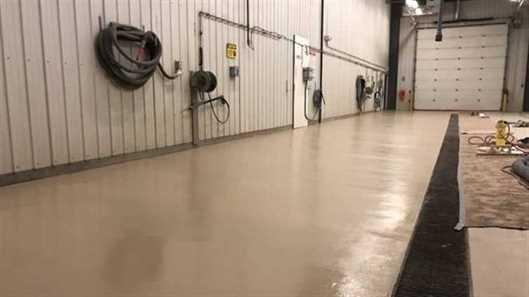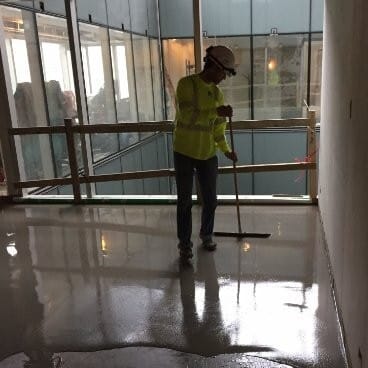 If you ask any experienced contractor, they’re likely to tell you the very same thing. Surface preparation is the key component to success of a repair, future floor covering, or polish. Whether you’re working on plywood subfloor or a concrete slab, you can’t underestimate the importance of taking time to adequately prepare for the next stages of construction. Taking the time to prepare concrete for the future is a little more time-consuming than preparing a wooden subfloor. You may be tempted to think that all concrete is the same, but that actually isn’t the case. Different floor coverings will require different concrete surface profiles. The surface profiles dictate how the concrete should look and feel before receiving a specific floor covering. Many people wonder if these numbers truly matter, but they can make a huge difference in the long-term success of your project. You can take a look at some of the most common questions regarding concrete profile to see what should come next on your project.
If you ask any experienced contractor, they’re likely to tell you the very same thing. Surface preparation is the key component to success of a repair, future floor covering, or polish. Whether you’re working on plywood subfloor or a concrete slab, you can’t underestimate the importance of taking time to adequately prepare for the next stages of construction. Taking the time to prepare concrete for the future is a little more time-consuming than preparing a wooden subfloor. You may be tempted to think that all concrete is the same, but that actually isn’t the case. Different floor coverings will require different concrete surface profiles. The surface profiles dictate how the concrete should look and feel before receiving a specific floor covering. Many people wonder if these numbers truly matter, but they can make a huge difference in the long-term success of your project. You can take a look at some of the most common questions regarding concrete profile to see what should come next on your project.
What is Concrete Surface Profile?
Before we can really dive into why it matters, it’s important to first discuss exactly what we mean by “concrete surface profile.” If you open up the technical specifications for your new floor covering, you’re likely to see a section that refers to the CSP or concrete surface profile. This number represents the smoothness or roughness of a concrete surface after it has been prepared. The scale itself was invented by the International Concrete Repair Institute (ICRI). It features nine different stages ranging from very smooth subfloors (rated at a CSP 1) to extremely rough surfaces (rated at a CSP 9).
Why Does Concrete Surface Profiling Matter?
The numbers listed in the specifications for a particular floor covering are extremely important. Contractors need to pay attention to the concrete surface profile because it ultimately determines how well your new covering is going to bond to the concrete. Not all coverings, adhesives, and sealers are created equal. Some of them will require more texture or “tooth” to retain staying power over the years to come. For example, thin sealers and coatings typically require a very low concrete surface profile. You may find that it needs a profile ranging between one and three. On the other hand, a thicker self-leveler may need a profile of five or six. The texture of the surface ultimately determines the bonding capability of your new covering, whether you intend to use a self-leveler, stain, or an adhesive.
How Do You Profile Concrete?
If you know that the concrete profile number really does matter, how do you go about preparing your substrate adequately? The final steps to prepare the concrete will be determined by the specific CSP that you’re attempting to achieve. It should be mentioned that all of the surface profiles will be obtained using additional equipment. You won’t be able to texturize the surface of your substrate without the assistance of a professional company who is experienced in identifying the proper CSP and operating the necessary equipment to transform your preexisting concrete. The lower surface profiles will require far less intensive work to add the small amount of required texture. In these cases, you may need to do a detergent scrubbing or acid etching to achieve the desired smooth finish for the lesser concrete surface profiles. As you rise higher on the scale of concrete surface profiles, the work to prepare the substrate becomes significantly more labor-intensive.
Concrete surface profiles of four to six may require grinding, shot-blasting, or scarifying. These will require tools that are well beyond what is available to the average homeowner, and they should be left to the professional to handle. At the very extreme end of the concrete surface profile scale, you may be required to mill some of your concrete in order to give it enough grip for a thick polymer adhesive or overlay. This is extremely labor-intensive and requires a great deal of experience to make these higher concrete surface profiles possible without ultimately destroying the entire surface. If you become overly enthusiastic with texturizing the surface for a higher CSP, you may end up creating a situation that will require additional repairs before you can move forward. Be sure to consult with experts and experienced technicians who can help determine the proper steps before you begin.
Considering Concrete Surface Profile
Before you decide on a specific type of flooring or overlay, you should really investigate the technical specifications it requires, TCF West may help you with that. You may want to begin having a conversation with your contractor early on to ensure that you have the space and budget to accommodate the necessary equipment or labor. If you’re on a tight timeline, this should also be a consideration. A more aggressive concrete surface profile may not be the best idea for your particular job based on the location and size of your space. For example, you may not have room to navigate the heavy-duty equipment that would be necessary for achieving a CSP of seven or higher.
You also need to consider the current condition of the concrete substrate before you begin. It may be very difficult to achieve a CSP 1 if your current slab is closer to an eight or a nine. More repairs may need to be made before you can accommodate the smoother surface. This could spell out significantly higher costs and more delays before you can continue to move forward on the rest of the project. Overall, there are plenty of things to consider when it comes to the concrete surface profile of a particular project. Homeowners and contractors should both be aware that ignoring these guidelines can mean future disasters when adhesives or overlays fail to stick to the subflooring. Preparation is key, so you should start having a conversation with your experienced contractor today.

